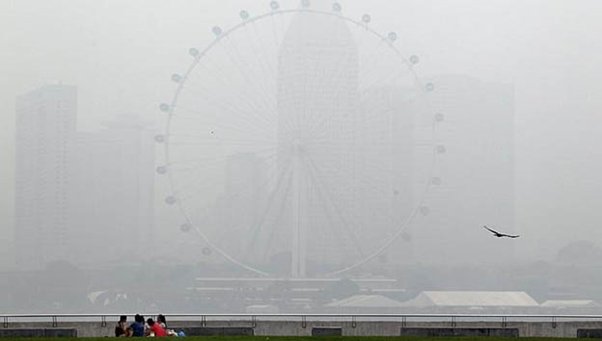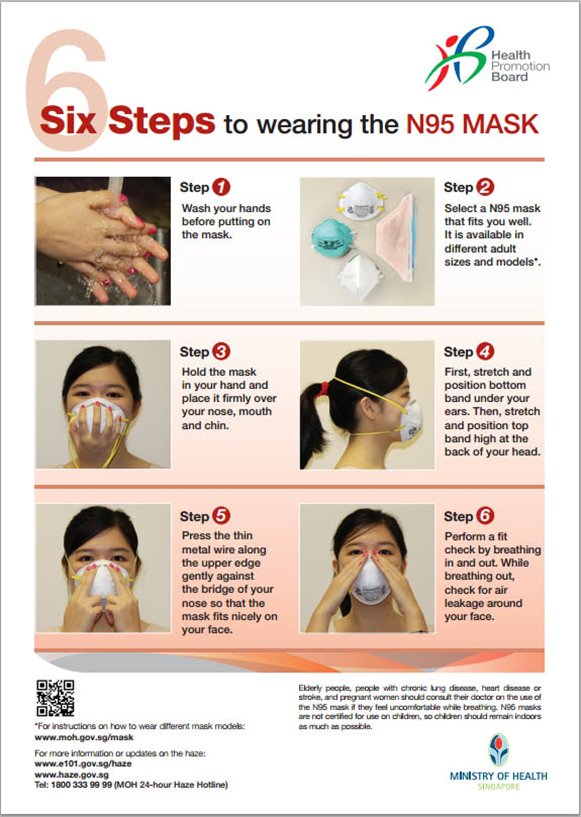How to protect yourself against the haze?

The haze in Singapore has been back for several weeks. It is not an exceptional event, for almost every dry season, outbreaks have occurred. Thick grey smog coming from Indonesia floats over the island causing people to stay indoors, closure of schools and unhealthy levels of pollution. Singapore’s air quality even reached hazardous levels and there is no indication on how long people will have to cope with this situation.
Cause of the haze
The current haze comes from forest burning triggered by illegal fires in peatland, and forest in Indonesia’s Sumatra Island and the Indonesian part of Borneo. These fires are created to quickly clear lands for palm oil, paper and pulp plantations
What is in the haze? How to check air quality?
The haze is predominantly composed of two types of particles:
– – PM10 are particulate matters of 10 microns in size. They are large enough to be trapped by the nasal passages when you breathe.
– – PM2.5 are fine particulate matters that are no larger than 2.5 microns, a thirtieth the diameter of a human hair. They can get trapped deep in the lungs and go into the bloodstream.
Short term exposure to high levels of haze particles can cause irritation of the eyes, nose, and throat in healthy individuals, while a long-term exposure to these particles on a regular basis can create heart and lung complications such as lung cancer or heart disease.
The PSI, Pollutant Standards Index gives information about air quality. Look for the three-hour PSI or 1-hour PM2.5 concentration levels published by the National Environment Agency (NEA). PSI is determined by the concentration levels PM10, PM2.5, sulphur dioxide, nitrogen dioxide, ozone, and carbon monoxide. During a normal day, without haze, the maximum concentration of PM2.5 is usually between 20 and 35 micrograms per cubic meters. The air is considered unhealthy when the concentration of PM2.5 hits 100, and hazardous when it exceeds 300.
How to protect yourself?
Stay indoors and close your windows and doors when the PSI is high
When the outdoor air quality reaches serious levels, stay indoors as much as possible and keep the windows and doors closed.
Cut down on physical activities
Exercising make you breathe deeply, allowing pollutants deep into your lungs. Reduce outdoor activities to limit your exposure to the haze especially when the PSI reaches 100 or more.
Stay hydrated
The haze causes drying conditions. Stay hydrated and drink more water than usual to flush out toxins absorbed by your body.
Use air purifiers at home.
Air purifiers and air ionizers can help to reduce the indoor particle level. Be sure to regularly change the filter to get rid of pollutants from the air efficiently.
Wear a mask.

Covering your nose with your hands is not enough to protect you. Wear a mask when the air pollutants levels are high. N95 masks seal to the face of the wearer and provide good protection against the haze as they keep fine particulate matter out. You can reuse your mask but don’t share it. Change it when it gets soiled or distorted in shape.
Teach people around you how to wear their mask. Not wearing your mask correctly can compromise its efficiency.
step to wear mask
Surgical masks and paper masks are not effective in filtering fine particles. They can reduce the discomfort caused by the haze and prevent the larger irritant particles in the air from being breathed in but do not provide adequate protection.
Avoid smoking.
Smoking can make your lungs more sensitive to the effects of air pollutants.
Eat a balanced diet
Eat lots of vegetables and fresh fruits to get enough nutrients to help your body deal with the haze.
Eat food containing Vitamin A such as liver, carrots, sweet potatoes or spinach. Vitamin A protects your eyes and shields your lungs from air pollution. The chemicals in the haze destroy the Vitamin A contained in the lung tissues, weakening your defence against carcinogens.
Take Vitamins E and Vitamins C complements to strengthen your immune system. The two vitamins taken in combination will also keep your lung tissue healthy by building up levels of a protective protein to prevent enzymes released during inflammation from destroying the lung’s elastic properties.
Sources:
National Environment Agency. 2016. HAZE SITUATION UPDATE. [ONLINE] Available at: http://www.haze.gov.sg/.
National Environment Agency. 2016. About Haze. [ONLINE] Available at: http://www.haze.gov.sg/about-haze.
Ministry of Health. 2015. MOH Haze Microsite. [ONLINE] Available at: https://www.moh.gov.sg/content/moh_web/home/pressRoom/Current_Issues/2014/haze.html.






